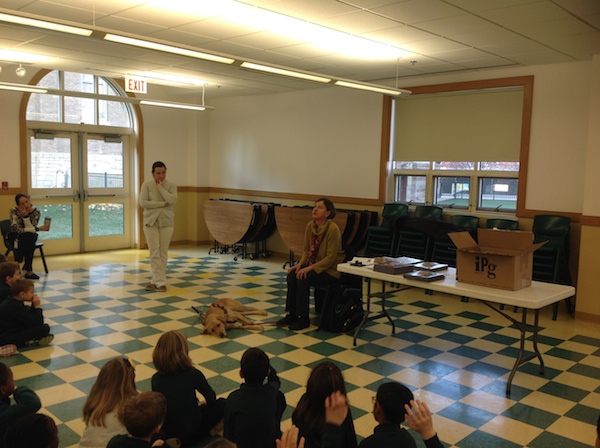Mondays with Mike: My Wife's out of Town, Her Seeing Eye Dog Isn’t
December 1, 2014 • 4 Comments • Posted in Beth Finke, blindness, guest blog, guide dogs, Mike Knezovich, Mondays with Mike, Seeing Eye dogs, UncategorizedSo, it’s already been a week since my last post? Yikes. A lot’s happened, and not all of it uplifting (though we had a swell Thanksgiving, and hope you did, too). So, bereft of inspiration, I’m repurposing a little something I wrote around 10 years back when Beth visited our friend Sheelagh in Northern Ireland and left Hanni home with me. I hope you enjoy it.
For years after my wife lost her eyesight, I dreaded when she went away without me. Not trusting a world of redcaps, connecting flights, and shuttle buses, I worried about her travels more than she did. I always imagined the worst, fretting until she returned home, safe.
Now she travels alone regularly. I’m still unhappy, but for less admirable reasons. A couple days before she goes out of town there’s a mix of sadness and tension. For her, it’s all anticipation and packing and every once in awhile an “I’m going to miss you.” For me it’s “I’m going to miss you, have a good time, but how come I’m stuck at home taking care of things while you’re having a good time?”
On her last trip she went to Northern Ireland, which meant she couldn’t take Hanni, her Seeing Eye guide dog. I’ll save the explanation, but it has to do with rabies quarantines and such. For a week, while Beth yucked it up and drank Guinness in a nice little pub with our friends, Hanni and I would be stuck with each other.
Still, on the day she left, I got a jolt of that thing that made Tom Cruise dance in his underwear in Risky Business when his parents left him home alone. No rules!
Except I’m not a teen-age Tom Cruise. I’m not an anything Tom Cruise. And there’s nothing I want to do that I haven’t done or don’t do regularly while my wife’s around. After 20 years of marriage, she’s seen it all; it’s not like I have to wait until she’s gone. If I had friends she despises I would make a point of seeing them. Except all my friends are her friends, too.
So my guilty pleasures amounted to eating food she’d never eat—barbecued ribs that night—and incessant channel surfing, watching sports, staying up into the wee hours catching fragments of action movies she’d never watch on cable TV. All because I could. The next morning I was groggy and heart-burned, wondering why I did this to myself.
With no payoff for her absence, I brooded. I was joined this time by Hanni, who acted like a child who’d been left with a mean relative. She went into a deep mope, curling up to sleep near the door to our apartment—she never, ever sleeps there otherwise.
And so for the first couple evenings, there we lay, me on the couch with remote in hand, she on the floormat by the door.
But after a couple of days, I started getting used to not having to consult with anyone on what to eat, what to do, where to go, or when to go there. To walking down the block to our local, just because I felt like it, to read the paper at the bar while sipping a beer. The good parts of being single that single people take for granted.
And there were good reports on the notes left by the dog-walker we hired for the week. “We had a great time at the park. Hanni was perfect, stopping at every curb. #1: Check. #2: Check. Gave her a treat.”
Hanni didn’t mind the new life, either. She wasn’t threading a blind woman through chaotic Chicago traffic anymore, but she still got fed and petted lavishly. I took her for long walks, she played with other dogs, and their companions struck up dog conversations with me.
Hanni and I bonded. I became certain we shared an ambivalence about my wife’s return. Who does she think she is, anyway? She goes away, we have to adjust. She wants to come back, we have to adjust. It’s all about her.
When a week passed, I left the office to pick up my wife at the airport. My cell phone rang, I answered, and a British woman introduced herself. She told me she sat next to my wife on the plane, that they had a great time talking, and that she’d help her to the curb with her luggage. I pulled up to find my wife and her British flying chum.
After I grabbed her bag, my wife said a hasty goodbye to her helper and we were off.
Like always, we started in as if resuming an interrupted conversation, each pouring out stories of the past few days as I drove downtown from O’Hare.
My stories stunk by comparison, of course. Between lists of who called, what teams won what games, and other droll details, I strategically mentioned the hardships I—and this time, the dog—suffered in my wife’s absence.
And like always, she ignored this accounting.
I made do with having made my comments for an imaginary record. We moved on to dinner plans for the night, the wheres, whats and whens, and charted out the rest of our week.
At home, whatever special bond the dog and I had forged evaporated before my eyes as Hanni, completely forgetful, forgiving, or both, threw herself at her partner without giving me a second look.
And it was like my wife never left.



